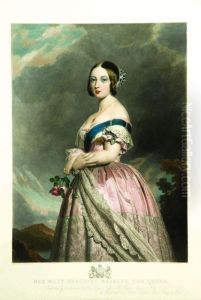Francois Forster Paintings
François Forster was a distinguished French engraver, born in Locle, Switzerland, in 1790. He moved to France, where he would eventually become one of the most celebrated engravers of his time, contributing significantly to the art world during the 19th century. Forster was renowned for his mastery in the technique of engraving, which involves incising a design onto a hard, flat surface by cutting grooves into it. This skill set him apart in an era where the reproduction of works of art was a vital means of dissemination and appreciation.
Forster's work was characterized by its incredible detail, precision, and the ability to capture the essence of the original paintings he replicated. He was particularly adept at translating the works of Renaissance and Baroque masters into engravings. Among his notable reproductions were works by Leonardo da Vinci, Raphael, and Titian. His engravings not only served to bring the masterpieces of these artists to a wider audience but also played a crucial role in the study and appreciation of their works, at a time when direct access to the originals was limited for most people.
In addition to his reproductions of classic works, Forster was also commissioned to create original engravings. His talent earned him the recognition and patronage of the French royalty and aristocracy. Throughout his career, François Forster received numerous awards and honors, including the prestigious title of Chevalier of the Legion of Honour, a testament to his contribution to French art and culture.
Forster's legacy is not only in the beauty and precision of his engravings but also in the role he played in the cultural exchange of art. By making masterpieces of Italian, Dutch, and French art accessible through his engravings, he fostered a greater appreciation and understanding of European art history. François Forster passed away in Paris in 1872, leaving behind a body of work that continues to be admired for its technical brilliance and artistic beauty.
